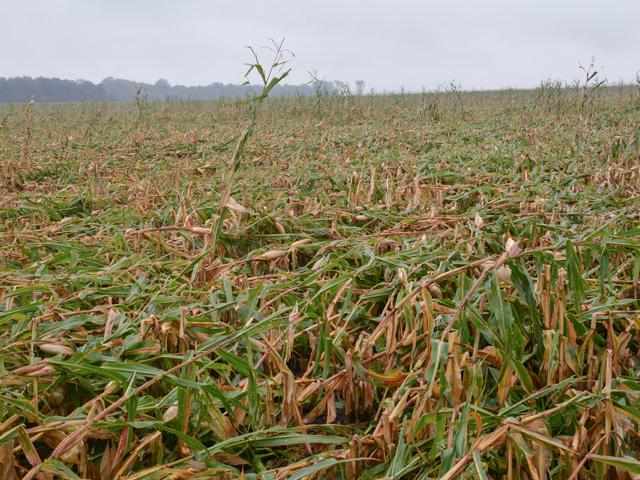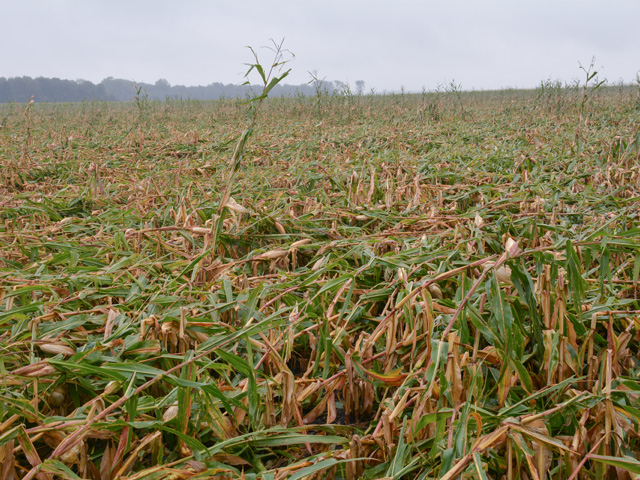Production Blog
After a Storm Strikes, Do You Know What to Do?
ANKENY, Iowa (DTN) -- Extreme weather events that cause substantial crop damage appear to be on the rise. Whether it's a derecho, hurricane, flood, hail or strong straight-line winds, reports of crops being destroyed or damaged by storms are regularly making the news.
A quick search of the www.dtnpf.com website backs that up. I typed in the name of each of the five examples of weather events above and the word crops -- for example, "derecho" and "crops." I totaled up more than 8,500 story hits. I won't make the claim that each story describes specific, different instances of crop damage by one of the weather events listed above; but it's a good bet most of the articles reference crop damage from storms.
After multiple thunderstorms with high winds pummeled many cornfields in the Upper Midwest in late August -- a little more than a year after the 2020 Midwest derecho flattened millions of acres of corn -- I thought it was time to remind farmers what steps to take to report crop damage. Harvest may be underway, but farmers know the crop isn't made until it's in the bin or off to market.
I enlisted the help of Pamela J. Stahlke, director of the regional USDA Risk Management Agency (RMA) in St. Paul, Minnesota, to provide the best information of what to do after a storm. The office serves Minnesota, Wisconsin and Iowa.
"Farmers have 72 hours from the initial time of discovery to report a notice of loss or damage to their crop insurance agent," Stahlke told DTN. "That could trigger an adjuster to come out. There can be a little bit of a grace period because sometimes losses aren't apparent right away. What is imperative is communication with their crop insurance agent."
Here are some frequently asked questions and answers put together by the RMA about reporting storm damage. Stahlke said the information was published to assist farmers after the 2020 Midwest derecho, but it applies to most storm-related losses. For the entire list, go to www.rma.usda.gov/en/News-Room/Frequently-Asked-Questions/August-10-2020-Derecho.
Q: What is an insurable loss?
P[L1] D[0x0] M[300x250] OOP[F] ADUNIT[] T[]
A: Adverse weather conditions are an insurable cause of loss. Adverse weather includes events such as hail, frost, freeze, wind, drought and excess moisture. Multi-Peril Crop Insurance covers damage to the crop in the field, not damage to farm infrastructure such as grain bins, irrigation equipment, livestock barns, etc.
Q: What do I do if my crop was damaged?
A: Producers should promptly notify their crop insurance agent to file a Notice of Loss (NOL) if they suspect damage or a loss in production due to wind or any other cause of loss. When a producer files a NOL, it allows Approved Insurance Providers (AIP) the opportunity to inspect and accurately appraise the production in order to timely settle any potential claims.
Q. How long do I have to file a NOL?
A: A NOL must be provided to the AIP within 72 hours of the initial time of discovery of damage or loss of production and confirmed in writing within 15 days. Under certain conditions, an AIP may accept a delayed NOL, when filing a timely NOL is not feasible.
Q: How will the AIP determine whether an indemnity will be paid?
A: AIPs will make this determination on a case-by-case basis. If the AIP determines field conditions will prevent producers from ever being able to mechanically harvest the crop, that production will not be counted and will be considered a full loss. If the producer chooses to harvest, an indemnity may be paid on the amount that falls below the insurance guarantee.
The producer may agree to settle the claim based on appraised production rather than taking to harvest. However, if production is later harvested, the producer must accept the higher of harvested production or appraised production for claims purposes. This may require a revised claim and repayment of any overpaid indemnity.
After crop-damaging storms, Stahlke said it can take weeks or months depending on what stage of development the crop is in for damage reports to trickle into regional RMA offices. As of Sept. 28, the St. Paul RMA office only had four reports of excessive wind damage to crops in August, and only one was for corn at 38.1 acres.
I have traveled through much of northeast Iowa since the late-August windstorms. The number of cornfields that sustained varying degrees of lodging was staggering -- easily in the thousands of acres. RMA officials don't expect to know the true estimate of the wind damage until claims filter in after harvest.
"It's a little bit of a process," she added.
In the advent that extreme wet and snowy conditions delay or prevent harvest, the RMA has information to help farmers as well. Farmers in North Dakota experienced a snow which stopped the 2019 harvest. Find that at www.rma.usda.gov/Fact-Sheets/National-Fact-Sheets/Delayed-Harvest---Wet-Conditions.
Matthew Wilde can be reached at matt.wilde@dtn.com
Follow him on Twitter @progressivwilde
(c) Copyright 2021 DTN, LLC. All rights reserved.






Comments
To comment, please Log In or Join our Community .